| Srl | Item |
| 1 |
ID:
183163
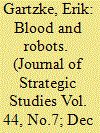

|
|
|
|
|
| Summary/Abstract |
New technologies such as Remotely Piloted Vehicles (RPVs) make it possible to remove human beings from direct involvement in combat. How will this evolving dynamic affect the practice and purposes of political violence? Will conflict become ‘costless’ in human terms as machines replace people on the front lines or will the logic of war continue to call for human sacrifice? While considerable attention has been devoted to the role of technology in transforming warfare, little is known about how new modes of combat will affect established motives for using force. I explore these political dimensions of new modes of conflict, drawing three basic conclusions. First, to the degree that substituting machines for humans lowers the costs for fighting, conflict will become more frequent, but less definitive. Second, in a reversal of previous trends, battlefield automation promises disproportionately to revitalise ground elements of military organisations. Finally, regrettably, new technologies should weaken inhibitions against targeting civilians.
|
|
|
|
|
|
|
|
|
|
|
|
|
|
|
|
| 2 |
ID:
183164
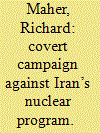

|
|
|
|
|
| Summary/Abstract |
This paper examines the covert campaign against Iran’s nuclear program and the implications it holds for both the theory and the practice of counterproliferation. The paper evaluates the degree to which covert action succeeded in producing meaningful delays and disruptions to Iran’s nuclear progress, in enhancing U.S. diplomatic leverage, and in helping to compel Iranian leaders to accept limits and restrictions on their country’s nuclear activities. More broadly, the paper analyzes the merits and viability of covert counterproliferation strategies, including how to define and measure the effectiveness of covert counterproliferation activity and how and under what conditions covert counterproliferation can be effective.
|
|
|
|
|
|
|
|
|
|
|
|
|
|
|
|
| 3 |
ID:
183162
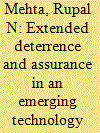

|
|
|
|
|
| Summary/Abstract |
How do emerging technologies impact strategic stability in the international system? I focus on how one aspect of strategic stability, extended deterrence commitments inherent to alliances, may be impacted by the development of new technologies and capabilities. I ask how technological innovations will impact the market deterrence and assurance dynamics in particular. I argue that while technologies may enhance the ability to provide extended deterrence, allies may be less assured by these new capabilities. To test these hypotheses, I explore emerging capabilities in new domains such as drones and hypersonic glide vehicles on international stability.
|
|
|
|
|
|
|
|
|
|
|
|
|
|
|
|
| 4 |
ID:
183166
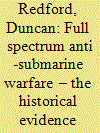

|
|
|
|
|
| Summary/Abstract |
Submarines are pressing their way back to the top of the maritime agenda. To deal with the burgeoning submarine threat, the full spectrum approach to anti-submarine warfare has been developed. Its ten threads hope to defeat – as opposed to destroy – hostile submarines. This paper will explore the historical evidence surrounding the full spectrum approach. It will argue that the historical evidence for many of the threads is weak, but that when the fundamentals of submarine warfare are considered many of the lessons of WW1 and WW2 may still be relevant to today’s practitioners.
|
|
|
|
|
|
|
|
|
|
|
|
|
|
|
|
| 5 |
ID:
183165
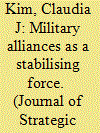

|
|
|
|
|
| Summary/Abstract |
Two broad and seemingly contradictory perspectives exist on U.S. alliances with South Korea and Taiwan. One focuses on how Washington carefully designed the alliances to rein in its overly warlike junior partners, while the other focuses on the surprisingly big influence of Seoul and Taipei that belied the power asymmetry in their relationships with Washington. This paper shows the influence of small allies is not a static feature of asymmetrical alliances designed to restrain them; small allies might exert unduly large influence at the stage of alliance formation, but once the alliance is institutionalised, they may lose much of the initial leverage. The findings lend empirical support to the view of alliances as a stabilising force, rather than a force multiplier, in international politics.
|
|
|
|
|
|
|
|
|
|
|
|
|
|
|
|